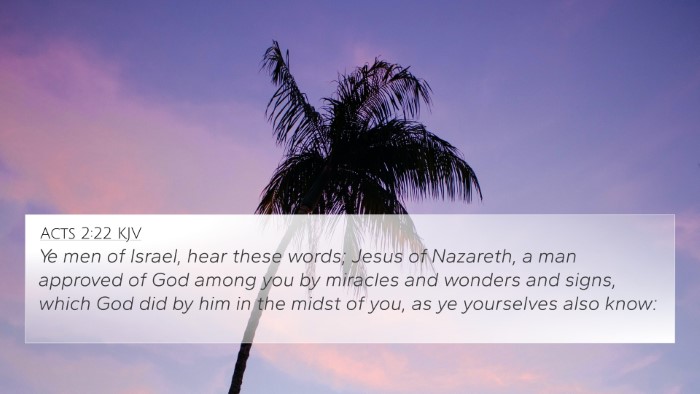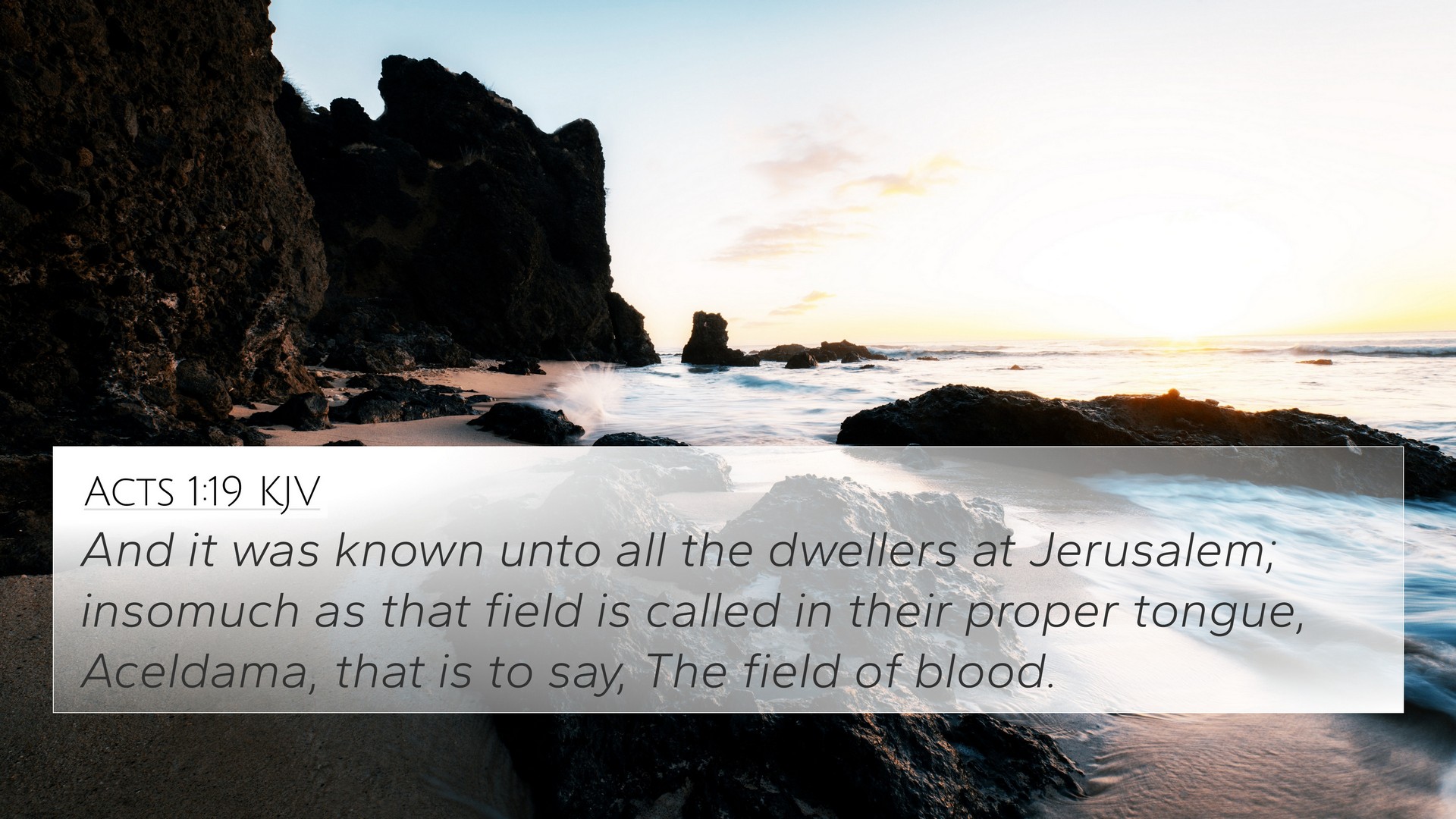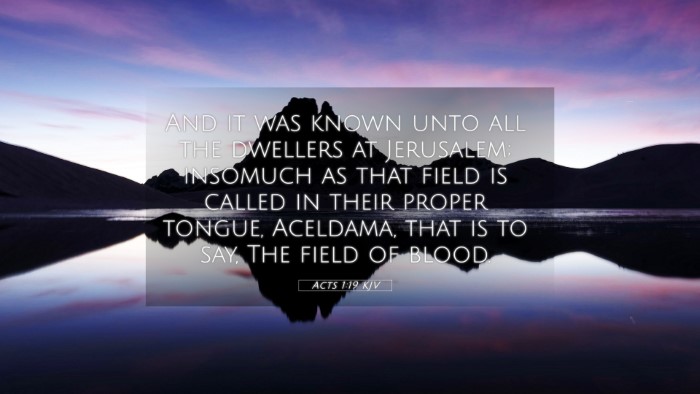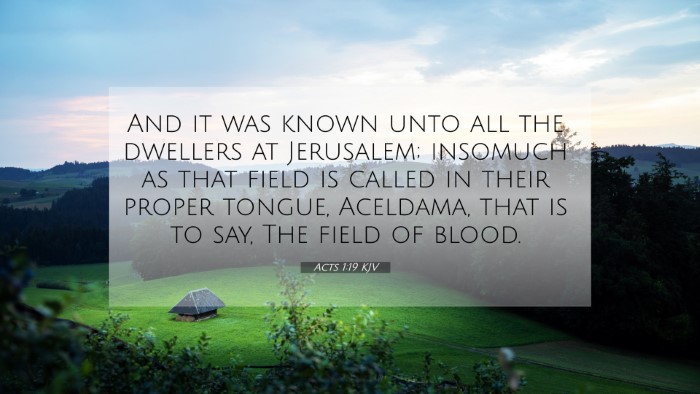Old Testament
Genesis Exodus Leviticus Numbers Deuteronomy Joshua Judges Ruth 1 Samuel 2 Samuel 1 Kings 2 Kings 1 Chronicles 2 Chronicles Ezra Nehemiah Esther Job Psalms Proverbs Ecclesiastes Song of Solomon Isaiah Jeremiah Lamentations Ezekiel Daniel Hosea Joel Amos Obadiah Jonah Micah Nahum Habakkuk Zephaniah Haggai Zechariah MalachiActs 1:19 Similar Verses
Acts 1:19 Cross References
And it was known unto all the dwellers at Jerusalem; insomuch as that field is called in their proper tongue, Aceldama, that is to say, The field of blood.
Uncover the Rich Themes and Topics of This Bible Verse
Listed below are the Bible themes associated with Acts 1:19. We invite you to explore each theme to gain deeper insights into the Scriptures.
Acts 1:19 Cross Reference Verses
This section features a detailed cross-reference designed to enrich your understanding of the Scriptures. Below, you will find carefully selected verses that echo the themes and teachings related to Acts 1:19 KJV. Click on any image to explore detailed analyses of related Bible verses and uncover deeper theological insights.

2 Samuel 2:16 (KJV) »
And they caught every one his fellow by the head, and thrust his sword in his fellow's side; so they fell down together: wherefore that place was called Helkathhazzurim, which is in Gibeon.

Matthew 28:15 (KJV) »
So they took the money, and did as they were taught: and this saying is commonly reported among the Jews until this day.

Acts 21:40 (KJV) »
And when he had given him licence, Paul stood on the stairs, and beckoned with the hand unto the people. And when there was made a great silence, he spake unto them in the Hebrew tongue, saying,

Acts 2:22 (KJV) »
Ye men of Israel, hear these words; Jesus of Nazareth, a man approved of God among you by miracles and wonders and signs, which God did by him in the midst of you, as ye yourselves also know:
Acts 1:19 Verse Analysis and Similar Verses
Understanding Acts 1:19
Acts 1:19 is a pivotal verse that details the fate of Judas Iscariot, representing a profound moment in the early Church's narrative. This summary consolidates insights from various public domain commentaries, allowing for a deepened understanding of this verse and its connections to other scripture.
Verse Text
Acts 1:19 (KJV): "And it was known unto all the dwellers at Jerusalem; insomuch as that field is called in their proper tongue, Aceldama, that is to say, The field of blood."
Summary and Interpretation
This verse refers to the aftermath of Judas Iscariot's betrayal of Jesus. The term “Aceldama” translates to “the field of blood,” signifying not only Judas' death but also the gravity of his actions that led to such a fate.
Commentary Insights
- Matthew Henry: Emphasizes the public recognition of Judas’ betrayal and its effects on the community. It fosters an understanding of moral consequences within the Biblical narrative.
- Albert Barnes: Notes that the field's name serves as a historical marker of Judas' treachery, thus ensuring that future generations remember the price of betrayal.
- Adam Clarke: Provides insights on the etymology and significance of “Aceldama,” suggesting it represents not just a place, but the mourning of lost potential and faith.
Bible Cross-References
Acts 1:19 can be connected with various other scripture verses that highlight themes of betrayal, sin, and redemption. Below are several cross-references:
- Matthew 27:3-5: Details Judas' remorse after betraying Jesus and his subsequent suicide.
- Psalm 69:25: Prophecy concerning the desolation of Judas, linking Old Testament foresight with New Testament events.
- Acts 1:18: Describes how Judas purchased the field and his end, establishing a direct context to Acts 1:19.
- Luke 22:48: Jesus acknowledges Judas as the betrayer, emphasizing the personal connection between Jesus and Judas.
- John 17:12: Jesus spoke of protecting His disciples, except for the "son of perdition," referring to Judas.
- Matthew 26:24: The prophetic declaration about Judas and the role of betrayal that leads towards calamity.
- Hebrews 6:4-6: Discusses the severity of falling away after receiving the truth, resonating with themes of betrayal.
Thematic Connections
Acts 1:19 not only illustrates the fate of a betrayer but also serves as a learning point on faithfulness and the weight of sin. The references tie into larger narratives such as:
- Betrayal and Consequences: The theme of betrayal runs through several texts, showing the serious implications of turning away from righteousness.
- Public Awareness of Sin: The awareness of Judas’ betrayal highlights the communal aspects of sin and its impact on society.
- Prophecy Fulfillment: The connection between Old Testament prophecy and New Testament fulfillment reinforces biblical continuity.
Tools for Effective Bible Cross-Referencing
For those seeking to delve deeper into cross-references and thematic connections in the Bible:
- Bible Concordance: An essential tool for finding direct relationships between verses.
- Bible Cross-Reference Guide: A practical resource for studying interconnected scriptures.
- Cross-Reference Bible Study: Methods to seamlessly integrate various texts for comprehensive understanding.
- Bible Reference Resources: Includes various translations and commentaries to see the context of verses.
- Identifying Connections: Techniques on how to uncover and study verses that interlace narratives and themes.
Conclusion
Understanding Acts 1:19 involves not just looking at the verse itself but placing it within a broader scriptural context. By exploring related verses and using cross-referencing tools, one can appreciate the intricate tapestry of meanings and lessons woven throughout the Bible. This method enriches personal study and aids in sermon preparation, leading to deeper theological reflection.


